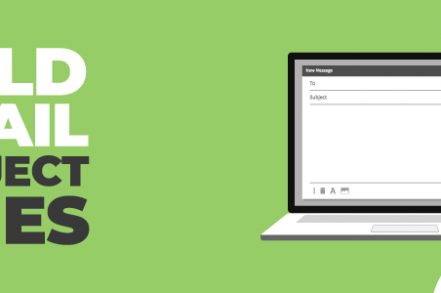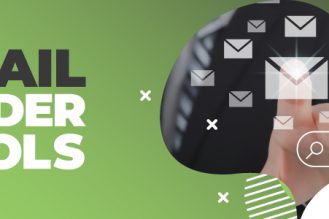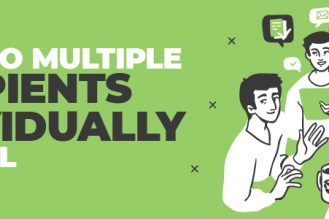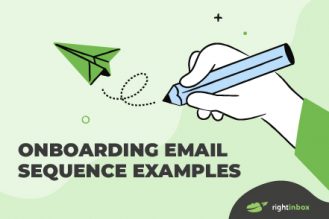The cold sales email is notoriously tricky to get right, however. But if done well, it can be incredibly powerful, yielding 8 times more opens and clicks and 6 times more revenue than any other type of email.
But the key to an effective cold email is the subject line. It’s the first thing your recipient will see when it lands in their inbox, and it can make the difference between your email getting opened or getting sent straight to the junk folder.
5 Things to keep in mind when writing cold email subject lines
1. Appearances matter
All-caps subject lines can be damaging to email open and response rates, while all-lowercase subject lines are thought to be more subtle and intriguing.
2. Personalization works
Consumers respond better to personalized messaging; for example, using the first name of your recipient in your subject line can increase click-through rates.
3. Sell the Click
Your only goal with the subject line is to sell the click. In other words, you want the recipient to be enticed to click into the body of the email. Don’t give too much away in your subject line. Save that for the email itself.
4. Keep it Short
Different email providers have different character limits for subject lines. Try to communicate what you want to say in as few words as possible, without beating around the bush.
5. Make it Clear Who the Email is For
Your subject line doesn’t always have to include your recipient’s name (and sometimes you won’t have that information). However, it should definitely speak to the specific market segment they belong to — that way it seems timely and relevant, increasing click throughs.
17 Subject Lines that Work
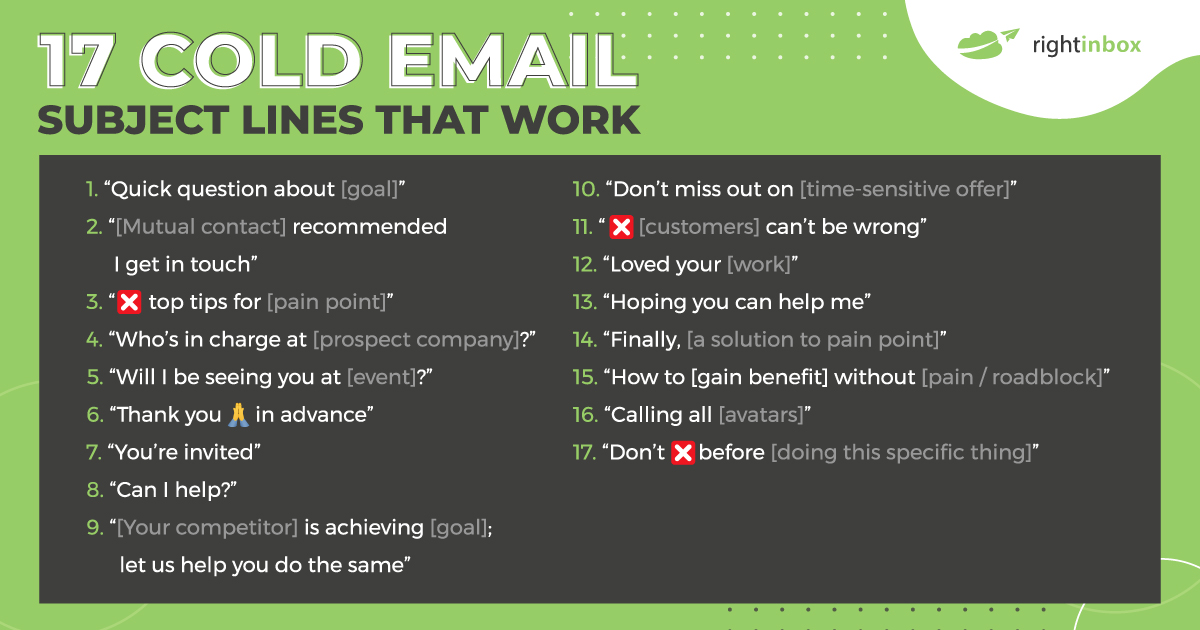
If you’re not quite sure what to say in your subject lines, here are 17 cold email subject lines that get results.
1. “Quick question about [goal]”
Why it works:
The beauty of this subject line is that it both mentions the recipient’s (or their company’s) goal and creates suspense. The recipient will only find out what the question is if they open the email and read your message.
Personalizing subject lines to address your recipient’s business goal, pain point, or USP is a sure-fire way of grabbing their attention. The trick is to ensure that your “quick question” within the email copy is genuine and well-considered. If it’s not, your recipient will feel tricked – and that’s not going to help your cause.
2. “[Mutual contact] recommended I get in touch”
Why it works:
When people look at their inbox, they’re subconsciously looking for keywords and familiar names. If they see a subject line that includes a name they know, they’re more likely to click on it.
This only works if the connection is genuine. For example, if you’ve recently been to a conference and met a mutual connection there, you can use that meeting as the basis for the initial introduction.
But even if you have an informal mutual contact, like a friend or family member, there’s no harm in using that to make a connection.
3. “[X] top tips for [pain point]”
Why it works:
People like lists, so highlighting a list in your subject line is a winning strategy. Chiming in with one of the recipient’s pain points will also help to pique their interest.
But the best thing about this subject line is that it suggests to your recipient that if they have a challenge on their hands, they’re not alone. What’s more, there are solutions, which you are helpfully providing to them.
This subject line only works if your email content demonstrates that you do actually have some answers. If you’re offering to be helpful, then be helpful. This is your chance to stand out as a credible source and a contact worth knowing.
4. “Who’s in charge at [prospect company]?”
Why it works:
This subject line cuts to the chase, which is often a good strategy when asking for an introduction. It works because it doesn’t try to establish the sender as an expert trying to offer advice. It asks for information, which can speak to people’s natural propensity to be of help.
This type of information-seeking email is much more appealing to recipients and is therefore more likely to mark the start of a conversation.
5. “Will I be seeing you at [event]?”
Why it works:
This one is great because it doesn’t necessarily need a response. By simply reading this subject line, your prospect will connect your name with the event. That instantly makes them more likely to recognize your name badge at the event or come to your booth if you have one.
If nothing else, it gives you a starting point from which to reintroduce yourself when the event comes around.
If the recipient does happen to open, read, and respond to your email, all the better. You can schedule a conversation at or after the event. Win-win.
6. “Thank you 🙏 in advance”
Why it works:
Emojis – once a relatively spammy option for marketers – are now proven to get results. In fact, 56% of brands using them in their subject lines experience higher open rates than those that don’t.
Experiment with creative subject lines, trying out different emojis. Track your open, click-through, and response rates to see what works and what doesn’t. After all, not all businesses or email campaigns are suited to emojis.
7. “You’re invited”
Why it works:
Making your subject line stand out doesn’t necessarily rely on using imagery. In fact, something as simple as keeping your subject line short is enough to make it stand out from the crowd.
The great thing about short subject lines is that they can be scanned and digested quickly. Shorter subject lines also seem less salesy and more conversational – guaranteed to get a second glance from your recipient. And given that 66% of all emails are now opened on mobile devices, subject lines of around 3-4 words are ideal.
8. “Can I help?”
Why it works:
The mantra of “Always Be Helping” should be at the heart of a salesperson’s strategy, and that starts with the first cold email. When your prospect sees the word “help” in the subject line, it will instantly get their attention.
Not only does this subject line create curiosity (“Help with what?”), but it also addresses your prospect’s potential challenge(s). A word of warning, however: make sure you do your homework and identify the right pain point, or you’ll lose their trust from the get-go.
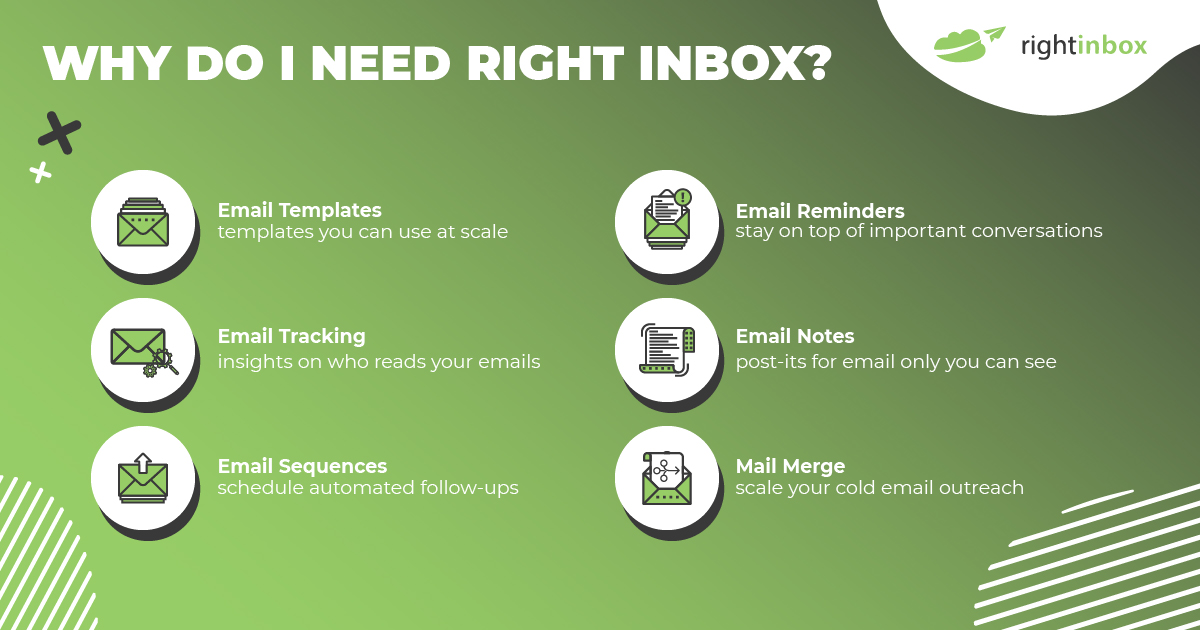
9. “[Your competitor] is achieving [goal]; let us help you do the same”
Why it works:
One thing businesses always have their eye on is the competition – so a competitor’s name showing up in their inbox will immediately grab their attention.
Not only is the competitor’s name likely to gain their interest, but so too is the goal you’ve identified. An email that could help them gain a competitive edge and achieve their goal(s) is bound to get opened.
10. “Don’t miss out on [time-sensitive offer]”
Why it works:
Emails that imply urgency are proven to get higher open rates. With cold sales emails, this is a useful tactic to portray an element of exclusivity. After all, if they don’t act now, then they’ll miss out on the offer.
The urgency subject line taps into FOMO (fear of missing out), a hallmark of the millennial generation. According to Eventbrite, this demographic (also the largest segment of the U.S. workforce) experiences a whopping 69% FOMO rate. Incidentally, it’s millennials who are most engaged, and most likely to share, recommend, and respond. Use this subject line to reach them, and you’ll have a winner.
11. “[x] [customers] can’t be wrong”
Why it works:
This is designed to create a very powerful sense of two things: social proof and curiosity. For instance, let’s say your market is real estate agents.
Your subject line could be “577 real estate agents can’t be wrong.” Naturally, your prospect is thinking “can’t be wrong about what?” which will lead them to click through.
Of course, when they read your email, you can explain how 577 people just like them have used your product or service and left glowing reviews, creating some instant trust that will help you sell more.
12. “Loved your [work]”
Why it works:
People love praise and appreciation almost more than anything else. And that’s exactly what you’re tapping into with this subject line.
Now, of course, you should have actually consumed this person’s work, or seen their conference keynote speech, or whatever you’re referring to.
By leading your cold email with a compliment, it allows you to explain why it makes sense for you to connect or work together, based on similar interests or values.
13. “Hoping you can help me”
Why it works:
People have an innate desire to help others. It simply feels good. So by directly asking for help, you’re hoping that an influencer or decision maker is feeling generous when they read your email.
You might not have the most established reputation or service to provide some logical value in your subject line. That’s where having a little humility can go a long way in getting your foot in the door.
14. “Finally, [a solution to pain point]”
Why it works:
By addressing their pain point, you’re bound to grab their attention right away. Imagine suffering from back pain, or a business struggling to recruit the right employees.
If you know your market enough to address their biggest concerns or problems, then mention it right away.
You’re mirroring the inner monologue they’re already having. And finally, there seems to be an effective way to get what they want after all this time.
15. “How to [gain benefit] without [pain / roadblock]”
Why it works:
It’s great to get rid of a pain point. And it’s wonderful to gain benefits — that’s simple psychology. But if there is a way to achieve both? You’ve got a powerful subject line.
This works particularly well for established markets where your prospect is already trying to solve their problem on their own or via a competitor.
For example, they might be gaining new clientele by cold calling names A-Z in a directory. If you run a lead generation agency, you could create a subject line like “How to gain 30 new customers this month without cold calling.”
16. “Calling all [avatars]”
Why it works:
There is no mistake who you’re talking to with this one. “Calling all plumbers” or “Calling all exhausted single moms” is going to speak directly to those people.
They will naturally assume that what you’re about to share with them is crafted just for avatars like them — and of course it should be if you’re going to use this subject line.
17. “Don’t [x] before [doing this specific thing]”
Why it works:
This subject line almost acts like a warning. It invokes a tiny bit of fear in your prospect that they make a big mistake if they try to achieve a particular result without knowing some important information.
Of course, they’ll need to read your email, and maybe click through to a landing page or other piece of your funnel to discover what exactly that is.
In summary
There’s no doubting the effectiveness of email as a sales and prospecting tool. That said, what makes outreach emails most successful is their subject line – the first impression you present to your recipients. A strong subject line will be short, personalized, and offer some incentive to open the email and read more – it’s all but guaranteed to bring you results.
Track emails, email reminders & templates in Gmail for free
Upgrade Gmail with the features it’s missing
Add to GmailDavid Campbell
David Campbell is the editor of the Right Inbox blog. He is passionate about email productivity and getting more done in less time.
